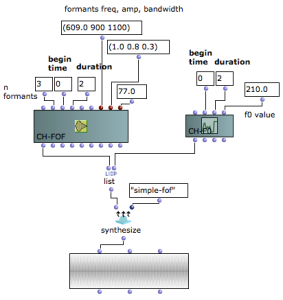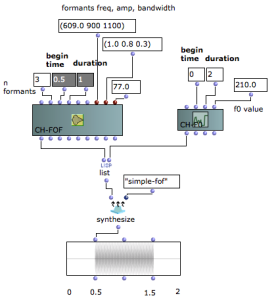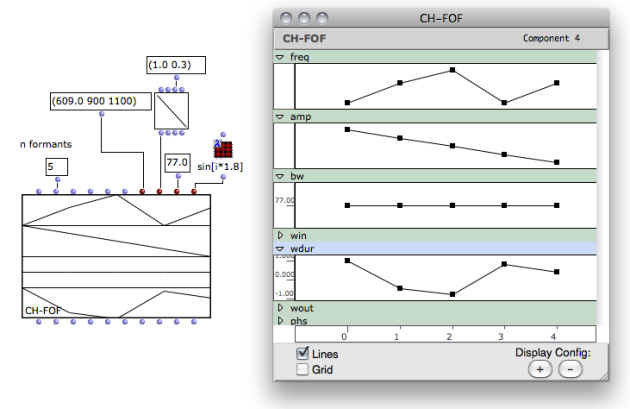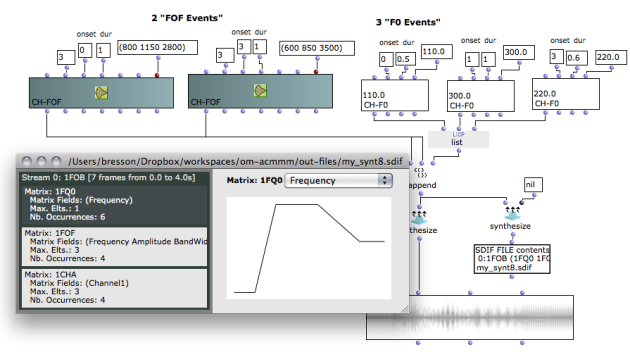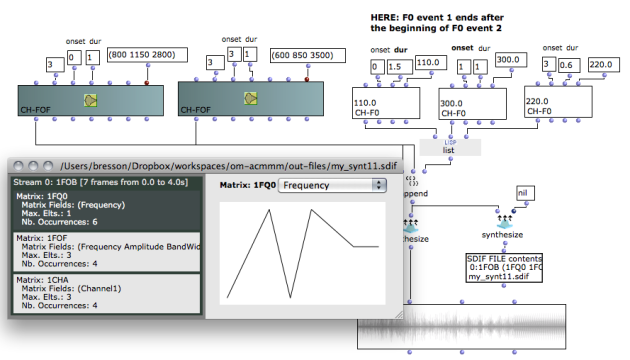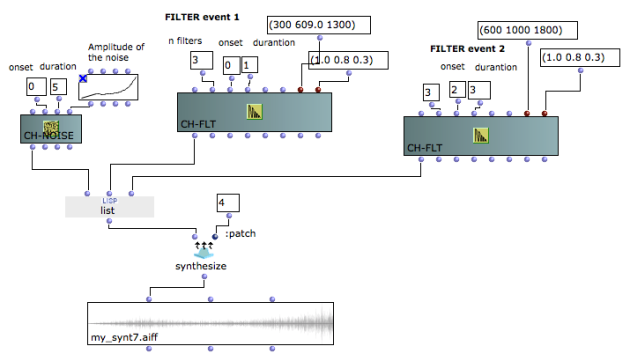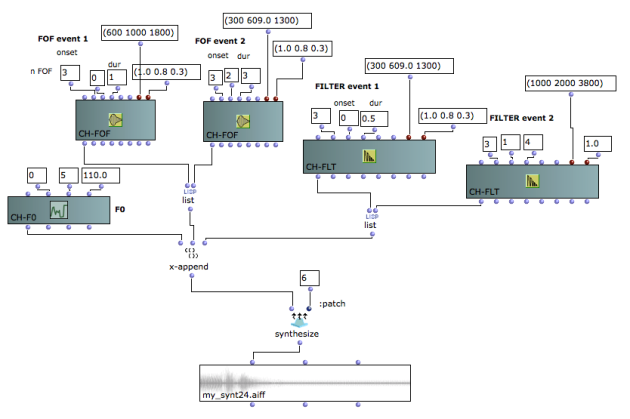Chant Events
Synthesis events[1] are high-level control structures, defined in the form of parameter matrices [components x parameters]. Each synthesis event (or matrix) has a number of parameters (e.g. frequency, amplitude, bandwidth) defined for a number of “components” (typically, the different formants in a Chant synthesis process). The synthesis events have an “onset” (also called action time) and a duration allowing for their organisation in a larger-scale time structure. As a result, each event produces at least 2 SDIF frames in the final control sequence, corresponding to the state of a module at the event onset and at its end (onset + duration).
Different types (or classes) of Chant events are defined to control the FOF module parameters (classes CH-FOF and CH-F0), the resonant filters (class CH-FLT) or the noise generators (CH-NOISE).
CH-F0 and CH-NOISE are not matrices but scalar controllers.
The generic function SYNTHESIZE performs the synthesis of the Chant events. Its main parameter is a list of events. From these events (and eventually following other keyword arguments) it does its best to format the SDIF control file with adequate initialization, and calls the synthesizer (via an internal can to CHANT-SYNTH).
Here is a basic example with Chant patch #0 (FOFs only). In this example use 1 event of type CH-FOF (a set of 3 FOF generators) and 1 event of type CH-F0 (the fundamental frequency controller of the FOFs). |
Note that the action-time and duration of the events must be set so that the F0 and FOF generators are both activated simultaneously, otherwise no sound will be produced by the synthesis patch. If the FOF event is not active all the time, for instance, the sound may be null before and after activation of the FOF modules. |
Setting the CHANT events attributes
All Chant event classes share the action-time and duration slots, which determine their temporal properties. In this section, we discuss the different means to set their other synthesis parameters.
Matrix events work on the model of the OMChroma synthesis events, based on the OM CLASS-ARRAY object. They are defined thanks to the general slot numcols, which determines the number of “components” (in the case of Chant events, the number of FOF generators – or formants – with CH-FOF, or the number of resonant filters with CH-FLT). Then, the other parameters are determined according to theinput data and following this number of components. The default value for numcols is 1. | 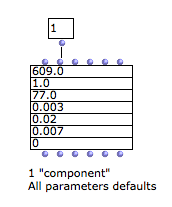 |
Use the “optional input” command [alt + →] to show the available parameters for CH-FOF or CH-FLT:
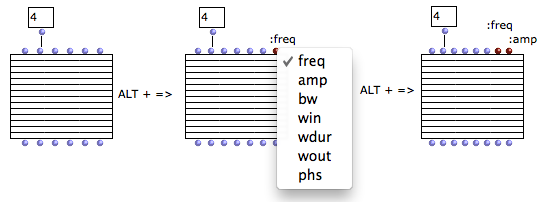
You can add as many inputs as you like (in the limit of the available slots). The hidden inputs will be assigned default values.
Use d to see the reference page of the objects an get for more information on the different parameters of the Chant event classes.
The CLASS-ARRAY provides different means to fill the contents of the matrix:
- One single value (number) will be considered constant and repeated for all the components.
Ex. numcols = 5, :amp = 0.5 => amp = [0.5 0.5 0.5 0.5 0.5]
- A list of values will be applied to the successive components (and repeated circularly if needed).
Ex. numcols = 5, :bw = (40 60) => bw = [40 60 40 60 40]
- A BPF will be sampled and applied according to the number of components.
Ex. numcols = 5, :freq = /\ (0 1 0) => freq = [0 0.5 1 0.5 0]
- A function (or patch mode ‘lambda') will be called iteratively with the component indices.
Ex. numcols = 5; :amp = (lambda (evt i) (* i 0.1)) => amp = [0.1 0.2 0.3 0.4 0.5]
Instead of numbers, each parameter of a Chant event's component can also be a curve, expressed with BPF objects in OM. In order to assign a (pseudo-) continuous evolution to one or several synthesis parameters during the event, just use a list(s) of BPFs instead of lists of numbers. | 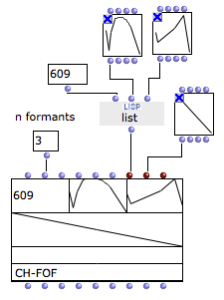 |
Get more info on the CLASS-ARRAY in the OM User Manual : http://support.ircam.fr/docs/om/om6-manual/co/ClassArray.html
The events of type CH-F0 and CH-NOISE are not matrices: they only embed one parameter (resp. the frequency of excitation of the FOF generator, or the amplitude of the noise). They are therefore easy to set and manipulate, either with single (constant) values or with BPFs (for a pseudo-continuous evolution of the controlled parameter). | 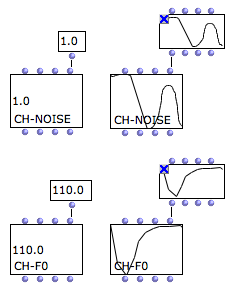 |
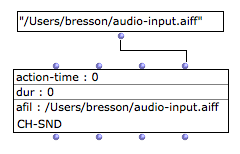 | CH-SND is a special event used in Chant patches 2, 3, 5, 7, 8 and 10 where a sound input is part of the synthesis process. As other events, CH-SND has an action-time and a duration. However, it has no other parameter than the path of the corresponding audio file. |
Synthesis
Use SYNTHESIZE to generate a sound out of a list of Chant event instances. The SYNTHESIZE generic function has a number of additional (keyword) inputs, of which some of them might be of a particular interest for Chant synthesis processes:
- sr: sample rate.
- duration: the total duration of the synthesis.
- name: the name of the sound file to synthesize.
- rescale: noralization of the output sound.
- patch: the Chant patch to use for synthesis [0-10].
- run: determines if the synthesizer is called or not.
If these arguments are not specified, SYNTHESIZE will do its best to guess:
- Which Chant patch must be used (depending of the type of the events)
- The total duration (according to the onsets and durations of the events)
If the run argument is NIL, SYNTEHSIZE will just create and return the SDIF control file. This option might be useful to inspect and debug the Chant processes using the control data.
“Phrases” and events combinations
The different classes of Chant events can be use to implement synthesis processes with one of the different Chant patches. Each event will determine the state and evolution of the parameters of a given module of the synthesis patch and for a given time interval. We can therefore use several events in order to generate time-structured “phrases” with the synthesizer.
Remember that, by default, Chant interpolates between successive states determined by the control process, producing continuous transitions.
The FOF generators require CH-FOF and CH-F0 controls: these two classes must always be used together.
In the following example (inspired from the tutorial patche "events"), we use two CH-FOF events (one at t=0, with duration=1s, the second one at t=3, duration = 1s as well) and one F0 event (t=0, duration = 4s).

As visible in the OM Listener window, SYNTHESIZE automatically deduced that we were using the Chant patch #0 (FOF generators only) :
OM > CHANT PATCH: 0
We used here two instances of the SYNTEHSIZE box: the first one synthesizes the sound and the second one, with the keyword argument “:run” set to NIL, just generates the SDIF control file. We can check by opening the SDIFFile editor that the two FOF “events” are visible in the SDIF frame sequence, and visualize the interpolation process between the frequencies of event 1 and 2.
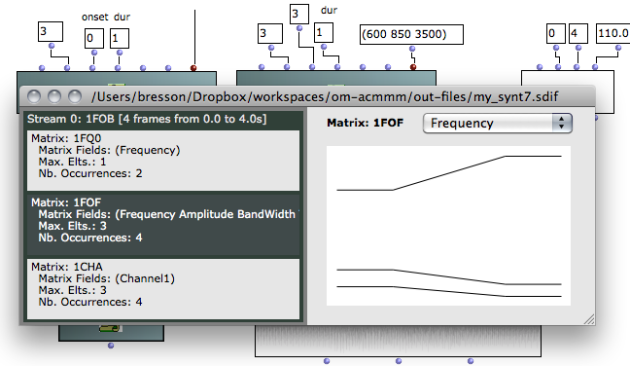
In this second example, we now add two F0 events. We can also check in the SDIF control file that the fundamental frequency in the control sequence follows our event-based construction.
In this example we see an advantage of separating the control of the FOFs (formant values) and of the F0 (fundamental frequency): FOFs and F0 can have free variations and time structures independently from one another.
In this example and the following, we minded never creating overlaps between events of the same type at setting the onsets and durations. Considering that every event produces one control value at its beginning and one value at its end in the SDIF frame sequence, and that the synthesizer interpolates between each two successive control values, an overlap of, say, the first two events in the previous example would produce the following effect:
[The sonogram of this sound is displayed in section “Displaying Results as a Sonogram”]
The situation will get even more complex with advanced time structures or when continuous values are used in the synthesis events. It will be discussed and handled specifically in Section “Transitions”.
Examples – Chant synthesis patches
The previous examples were all using Chant patch #0 (FOF generator only). Here are some examples of other Chant synthesis processes using different possible Chant “patches”.
As far as possible SYNTHESIZE tries to guess which Chant patch to use and initialize depending on the input Chant events. However, the patch can also be set explicitly if needed, or in case the event information is not enough to precisely determine the synthesizer's configuration (e.g. patches #1 and #9, or #7 and #10, use the exact same types of modules, connected differently).
Patch #4 filters a noise (possibly controlled in time using events or continuous variations) with one or several filter events (hence, the filter can also be controlled in a “phrase-based” fashion).
The sonogram below shows the evolution of the noise amplitude, the “filter events” stable states and the transition created by the synthesizer.
Patch #5 permits the same kind of process as patch #4, but with an input sound file.
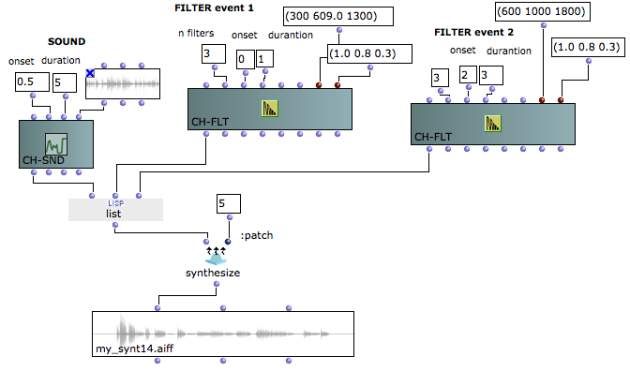
There can be only 1 sound file module (and 1 CH-SND event) running in a Chant synthesis process.
Patch #6 filters the output of the FOF with a resonant filter bank. Of course, filters and FOF events are not necessarily related.
The SDIFFile editor shows the different evolution of FOF and filter parameters:
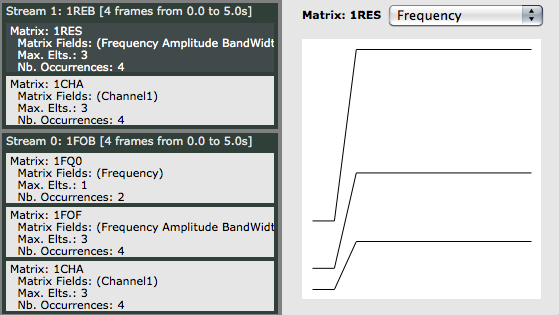

Patch #1 and #9 use the same modules but connect them differently. Patch #9 is a “merge” of patches #0 and #4: the FOF synthesis is added to the filtered noise. In patch #1 however, the FOF is first merged to the noise, and then the result is filtered.
In the example below are present FOF and F0 events, a Filter event, and a Noise event. The filter's amplitudes are set by a BPF describing an evolution from 0 to 1 on the whole 5 seconds of sound (see section “Continuous control”). If the synthesis process is run with patch #1, this filter applied to all source inputs (the FOF and the Noise). With patch 9 however, the FOF input is constant and the filter applies only to the Noise.
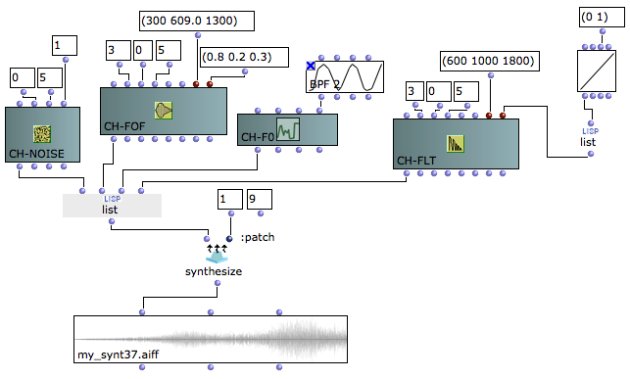
Due to the differences in the paths and processing, the relative amplitudes of the FOFs, Noise and filters may need to be readjusted depending on the configurations. In the previous example, if a same order is acceptable with Patch #1 (noise amplitude = 1, FOFs = 0.8, etc.), with Patch 9 (where only the noise go through the filter) either the noise or filter amplitudes will need to be divided (in this case appx. by a factor 100).
- Synthesis event
The notion of synthesis event is inspired from the similar concept in the OMChroma framework. See http://repmus.ircam.fr/cao/omchroma
